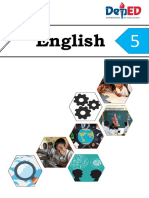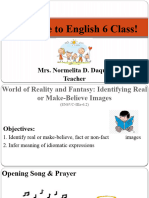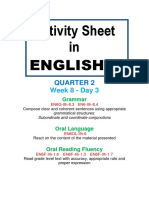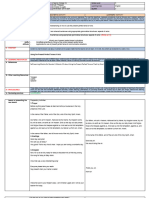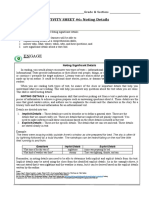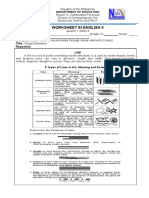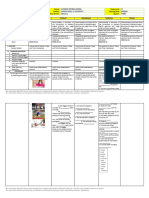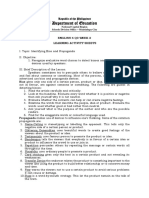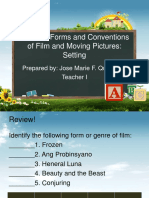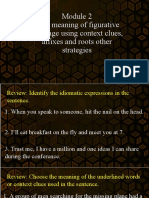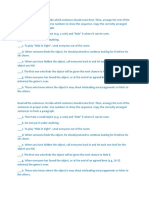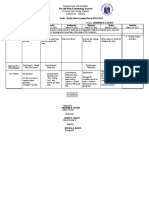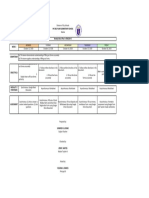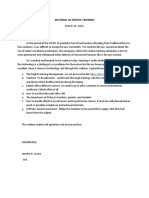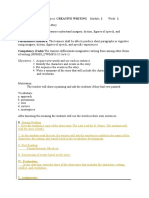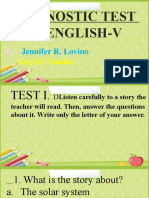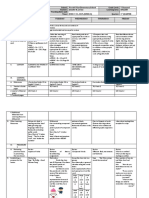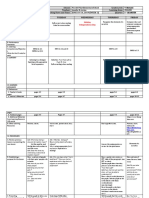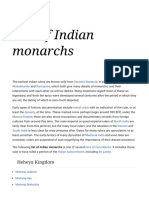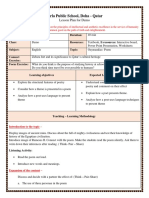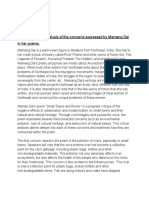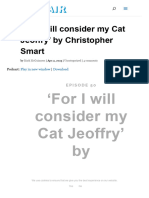100%(1)100% found this document useful (1 vote)
656 viewsInfer Meaning of Figurative Language Using Context Clues, Affixes and Roots Other Strategies
This document provides a summary of key concepts around figurative language including idioms, context clues, affixes, roots, similes, metaphors, personification, and hyperbole. It provides examples of each concept and asks students to identify examples and the type of figurative language being used. It concludes by asking students to take a quiz on the concepts in their Google Classroom.
Uploaded by
Jing ReginaldoCopyright
© © All Rights Reserved
Available Formats
Download as PPTX, PDF, TXT or read online on Scribd
100%(1)100% found this document useful (1 vote)
656 viewsInfer Meaning of Figurative Language Using Context Clues, Affixes and Roots Other Strategies
This document provides a summary of key concepts around figurative language including idioms, context clues, affixes, roots, similes, metaphors, personification, and hyperbole. It provides examples of each concept and asks students to identify examples and the type of figurative language being used. It concludes by asking students to take a quiz on the concepts in their Google Classroom.
Uploaded by
Jing ReginaldoCopyright
© © All Rights Reserved
Available Formats
Download as PPTX, PDF, TXT or read online on Scribd
You are on page 1/ 15
Module 2
Infer meaning of figurative
language using context clues,
affixes and roots other
strategies
Review: Identify the idiomatic expressions in the
sentence.
:
1. When you speak to someone, hit the nail on the head.
2. I’ll eat breakfast on the fly and meet you at 7.
3. Trust me, I have a million and one ideas I can share
during the conference.
Review: Choose the meaning of the underlined words
or context clues used in the sentence.
:
1. A group of men searching for the missing plane had a
perilous journey across the mountains.
A. easy C. safe
B. dangerous D. harmless
2. It’s a mixed emotion seeing my father for the first time.
A. different feelings C. angry
B. overwhelmed D. sad
Read the poem and answer the
questions that follow.
:
Flint
(Cristina Rossetti)
An emerald is as green as grass,
A ruby red as blood;
A sapphire shines as blue as heaven;
A flint lies in the mud.
Accepting ones opinion
A diamond is a brilliant stone,
To catch the world’s desire;
An opal holds a fiery spark;
But a flint holds a fire.
Figurative language is when you use a word or
phrase that does not have its normal every day, literal
meaning. Writers can use figurative language to make
their work more interesting or more dramatic than
literal language which simply states facts.:
1. I am so hungry I could eat a horse.
2. Chris won’t drive her home because she lives on the
other side of the universe.
3. I could sleep for a year, I was so tired.
Simile-a figure of speech that directly
compares two unlike things using like
or as.
1.My love is like a red, red rose.
2. She swims like a fish.
3. Lyka is as sweet as an ice cream.
4. He is as hairy as a gorilla.
A metaphor is a figure of speech that is used to
make a comparison between two things that aren't
alike but do have something in common.
1. Laughter is the music of the soul.
2. Her lovely voice was music to his ears.
3. The world is pandemic.
Personification is when you give an animal or
object qualities or abilities that only a human can have
1. Lightning danced across the sky.
2. My alarm clock yells at me to get out of bed
every morning.
3. The wind howled in the night
Hyperbole is an exaggeration used for emphasis
or humor.
1. That man is as tall as a house.
2. My dad will kill me when he comes home.
3. He's running faster than the wind.
Identify whether the sentence is a
Simile, Metaphor, Personification or
hyperbole.
1. My pencil costs me a million pesos. :
2. The calm lake was beautiful.
3. He is as strong as an ox.
4. The car danced across the road.
5. The flower is like a sun.
Evaluation: Identify the sentences. Write Simile,
Metaphor, hyperbole or personification. :
1. The snow is a white blanket.
2. She is as skinny as a toothpick.
3. The angry clouds marched across the sky.
4. This house is like a mall.
5. The flowers nodded their heads in the breeze.
Key to Correction:
1. Metaphor
2. Hyperbole or Simile
3.P Personification
4. Simile
5. Personification
Homework:
Take the quiz in your Google Classroom.
You might also like
- Pronoun - Reference Agreement (Gender, Case, Number)No ratings yetPronoun - Reference Agreement (Gender, Case, Number)15 pages
- Day 1-Analyzes Sound Devices (Onomatopoeia, AlliterationNo ratings yetDay 1-Analyzes Sound Devices (Onomatopoeia, Alliteration24 pages
- Note Down Relevant Information From Text Heard100% (2)Note Down Relevant Information From Text Heard10 pages
- Detect Biases and Propaganda Devices Used by Speakers100% (3)Detect Biases and Propaganda Devices Used by Speakers38 pages
- DLL-For Final Demo Using Present Perfect Tense of The Verb. Group 12No ratings yetDLL-For Final Demo Using Present Perfect Tense of The Verb. Group 1210 pages
- Compose Clear and Coherent Sentences Using Appropriate Grammatical Structures Pronoun-Reference Agreement Number, Case, GenderNo ratings yetCompose Clear and Coherent Sentences Using Appropriate Grammatical Structures Pronoun-Reference Agreement Number, Case, Gender21 pages
- Rubrics For Performance Tasks Q2-ENGLISH 6No ratings yetRubrics For Performance Tasks Q2-ENGLISH 62 pages
- LESSON EXEMPLAR IN ENGLISH 6 Jan.15 2018No ratings yetLESSON EXEMPLAR IN ENGLISH 6 Jan.15 20185 pages
- (English 6 Week 2 Lesson 2) - Analyzing Pictures100% (1)(English 6 Week 2 Lesson 2) - Analyzing Pictures29 pages
- Gear Up: Activity Sheet #6: Noting DetailsNo ratings yetGear Up: Activity Sheet #6: Noting Details4 pages
- Lesson Plan in English VI September 04, 2019 I. ObjectivesNo ratings yetLesson Plan in English VI September 04, 2019 I. Objectives5 pages
- ENGLISH 6 PPT Q3 W6 - Composing Clear and Coherent Report On Differing Viewpoints On An IssueNo ratings yetENGLISH 6 PPT Q3 W6 - Composing Clear and Coherent Report On Differing Viewpoints On An Issue12 pages
- Eng q1 w3 Identify The Values Suggested in Visual MediaNo ratings yetEng q1 w3 Identify The Values Suggested in Visual Media38 pages
- English Long Quiz Irony and Hyperbole and Idioms100% (1)English Long Quiz Irony and Hyperbole and Idioms2 pages
- Evaluate Narratives Based On Character and Setting100% (7)Evaluate Narratives Based On Character and Setting26 pages
- Remediation Learning Activity Sheet #1: Identify Various Types of Informational/Factual Text and Its Purpose100% (2)Remediation Learning Activity Sheet #1: Identify Various Types of Informational/Factual Text and Its Purpose7 pages
- Lesson Plan in Grade 6 English 3Rd Quarter Week 1 Day2 I. Objectives50% (2)Lesson Plan in Grade 6 English 3Rd Quarter Week 1 Day2 I. Objectives3 pages
- Note Significant Details of InformationNo ratings yetNote Significant Details of Information36 pages
- English-6-Q2-Module-2-Lesson-2-.version 3 PDF100% (1)English-6-Q2-Module-2-Lesson-2-.version 3 PDF20 pages
- Second Grading - Week 11 Code: En6Rc-Iiia-3.2.8100% (1)Second Grading - Week 11 Code: En6Rc-Iiia-3.2.86 pages
- Q2 Week 1 Day 5 Images Ideas That Are Explicitly Used To Influence Viewers100% (1)Q2 Week 1 Day 5 Images Ideas That Are Explicitly Used To Influence Viewers13 pages
- English 6 - Week 2: Objective: Interpret The Meaning Suggested in Visual Media Through A Focus On Visual Elements100% (5)English 6 - Week 2: Objective: Interpret The Meaning Suggested in Visual Media Through A Focus On Visual Elements2 pages
- Department of Education: Republic of The Philippines100% (4)Department of Education: Republic of The Philippines4 pages
- Different Forms and Conventions of Film and Moving Pictures Setting - July 19, 201975% (4)Different Forms and Conventions of Film and Moving Pictures Setting - July 19, 201920 pages
- Infer Meaning of Figurative Language Using Context Clues, Affixes and Roots Other StrategiesNo ratings yetInfer Meaning of Figurative Language Using Context Clues, Affixes and Roots Other Strategies15 pages
- GRADES 1 To 12 Daily Lesson Log Monday Tuesday Wednesday Thursday FridayNo ratings yetGRADES 1 To 12 Daily Lesson Log Monday Tuesday Wednesday Thursday Friday4 pages
- Template 2: DEFINITIVE BUDGET OF WORK FOR SY 2021-2022 (Languages)100% (1)Template 2: DEFINITIVE BUDGET OF WORK FOR SY 2021-2022 (Languages)4 pages
- Pio Del Pilar Elementary School: Department of Education Pureza, Sta. Mesa, Manila School ID: 136472No ratings yetPio Del Pilar Elementary School: Department of Education Pureza, Sta. Mesa, Manila School ID: 1364722 pages
- Pio Del Pilar Elementary School: Department of Education Pureza, Sta. Mesa, Manila School ID: 136472No ratings yetPio Del Pilar Elementary School: Department of Education Pureza, Sta. Mesa, Manila School ID: 1364722 pages
- IV. Evaluation: in The Chat Box, Write The Story of The Short Story That Includes The Characters, SettingNo ratings yetIV. Evaluation: in The Chat Box, Write The Story of The Short Story That Includes The Characters, Setting2 pages
- Pio Del Pilar Elementary School: Department of Education Pureza, Sta. Mesa, Manila School ID: 136472No ratings yetPio Del Pilar Elementary School: Department of Education Pureza, Sta. Mesa, Manila School ID: 1364722 pages
- Grades 1 To 12 Daily Lesson Log: Pio Del PilarelementaryschoolNo ratings yetGrades 1 To 12 Daily Lesson Log: Pio Del Pilarelementaryschool10 pages
- GRADES 1 To 12 Daily Lesson Log: I. ObjectivesNo ratings yetGRADES 1 To 12 Daily Lesson Log: I. Objectives6 pages
- Full Download Berlitz Pocket Guide Krakow 5th Edition Berlitz Publishing PDF DOCX100% (4)Full Download Berlitz Pocket Guide Krakow 5th Edition Berlitz Publishing PDF DOCX65 pages
- NCERT-Books-for-class 12-English-Poetry-Chapter 3 PDFNo ratings yetNCERT-Books-for-class 12-English-Poetry-Chapter 3 PDF3 pages
- 4th Semester Syllabus 2025 CU CCF NEP FYUGPNo ratings yet4th Semester Syllabus 2025 CU CCF NEP FYUGP7 pages
- Citation: Dr. Abaseen Yousafzai Pride of Performance Cultural ActivistNo ratings yetCitation: Dr. Abaseen Yousafzai Pride of Performance Cultural Activist1 page
- 10th Samacheer Kalvi English Paper I Sample 6 With AnswerNo ratings yet10th Samacheer Kalvi English Paper I Sample 6 With Answer11 pages
- For I Will Consider My Cat Jeoffry' by Christopher Smart - A Mouthful of AirNo ratings yetFor I Will Consider My Cat Jeoffry' by Christopher Smart - A Mouthful of Air16 pages
- Managing in a Global Economy Demystifying International Macroeconomics 2nd Edition Marthinsen Solutions Manual pdf download100% (3)Managing in a Global Economy Demystifying International Macroeconomics 2nd Edition Marthinsen Solutions Manual pdf download37 pages
- Cormac McCarthy and The Aesthetics of ExhaustionNo ratings yetCormac McCarthy and The Aesthetics of Exhaustion18 pages
- History of English Literature Objective Questions Including Tag Questions81% (36)History of English Literature Objective Questions Including Tag Questions30 pages

